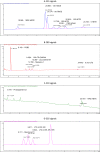Lipoxins, RevD1 and 9, 13 HODE as the most important derivatives after an early incident of ischemic stroke
- PMID: 32732956
- PMCID: PMC7393087
- DOI: 10.1038/s41598-020-69831-0
Lipoxins, RevD1 and 9, 13 HODE as the most important derivatives after an early incident of ischemic stroke
Abstract
There is limited information available regarding the association of plasma free fatty acids (FFA) and inflammation mediators with ischemic stroke. At the same time, new treatment strategies are being pursued. The aim of this study was to carry out a thorough analysis of inflammation with multiple FFA-derivative mediators after and ischemic stroke and standard treatment. HPLC separations of 17 eicosanoids were performed using an Agilent Technologies 1,260 liquid chromatograph. The profiles of the esters of fatty acids were labelled by means of gas chromatography. FFA, and eicosanoid profiles in the group of patients after ischemic stroke significantly differed from the profile of the control group. Studies confirmed the involvement of derivative synthesis pathways responsible for the inflammation, especially palmitic acid (9 and 13 HODE), arachidonic acid, EPA and DHA. Arachidonic acid derivatives were synthesised on 5LOX, 15 LOX and COX pathways with the participation of prostaglandins while omega 3 derivatives strengthened the synthesis of resolvins, RevD1 in particular. The ability to accelerate the quenching of inflammation after ischemic stroke seems to be a promising strategy of stroke treatment in its early stage. In this context, our study points to lipoxins, RevD1, and 9, 13 HODE as the most important derivatives.
Conflict of interest statement
The authors declare no competing interests.
Figures








Similar articles
-
Lipoxins and new lipid mediators in the resolution of inflammation.Curr Opin Pharmacol. 2006 Aug;6(4):414-20. doi: 10.1016/j.coph.2006.02.006. Epub 2006 Jun 5. Curr Opin Pharmacol. 2006. PMID: 16750421 Review.
-
Identification of inflammatory and proresolving lipid mediators in bone marrow and their lipidomic profiles with ovariectomy and omega-3 intake.Am J Hematol. 2008 Jun;83(6):437-45. doi: 10.1002/ajh.21170. Am J Hematol. 2008. PMID: 18429055
-
The Role of Resolvins: EPA and DHA Derivatives Can Be Useful in the Prevention and Treatment of Ischemic Stroke.Int J Mol Sci. 2020 Oct 15;21(20):7628. doi: 10.3390/ijms21207628. Int J Mol Sci. 2020. PMID: 33076354 Free PMC article. Review.
-
Factors influencing the eicosanoids synthesis in vivo.Biomed Res Int. 2015;2015:690692. doi: 10.1155/2015/690692. Epub 2015 Mar 11. Biomed Res Int. 2015. PMID: 25861641 Free PMC article. Review.
-
Formation of lipoxins and resolvins in human leukocytes.Prostaglandins Other Lipid Mediat. 2023 Jun;166:106726. doi: 10.1016/j.prostaglandins.2023.106726. Epub 2023 Mar 4. Prostaglandins Other Lipid Mediat. 2023. PMID: 36878381 Review.
Cited by
-
Smoking Affects the Post-Stroke Inflammatory Response of Lipid Mediators in a Gender-Related Manner.Biomedicines. 2022 Dec 29;11(1):92. doi: 10.3390/biomedicines11010092. Biomedicines. 2022. PMID: 36672599 Free PMC article.
-
Profile of uterine flush lipid mediators in cows with subclinical endometritis: pilot study.J Vet Med Sci. 2024 May 6;86(5):518-523. doi: 10.1292/jvms.23-0450. Epub 2024 Mar 25. J Vet Med Sci. 2024. PMID: 38522898 Free PMC article.
-
Fatty Acid Levels and Their Inflammatory Metabolites Are Associated with the Nondipping Status and Risk of Obstructive Sleep Apnea Syndrome in Stroke Patients.Biomedicines. 2022 Sep 6;10(9):2200. doi: 10.3390/biomedicines10092200. Biomedicines. 2022. PMID: 36140306 Free PMC article.
-
Level of Potassium Is Associated with Saturated Fatty Acids in Cell Membranes and Influences the Activation of the 9 and 13 HODE and 5 HETE Synthesis Pathways in PCOS.Biomedicines. 2022 Sep 9;10(9):2244. doi: 10.3390/biomedicines10092244. Biomedicines. 2022. PMID: 36140345 Free PMC article.
-
Free Fatty Acids and Their Inflammatory Derivatives Affect BDNF in Stroke Patients.Mediators Inflamm. 2020 Dec 3;2020:6676247. doi: 10.1155/2020/6676247. eCollection 2020. Mediators Inflamm. 2020. PMID: 33343231 Free PMC article.
References
Publication types
MeSH terms
Substances
LinkOut - more resources
Full Text Sources
Medical
Research Materials

